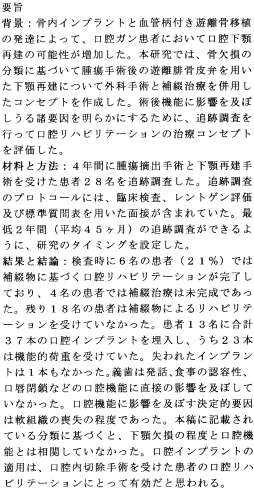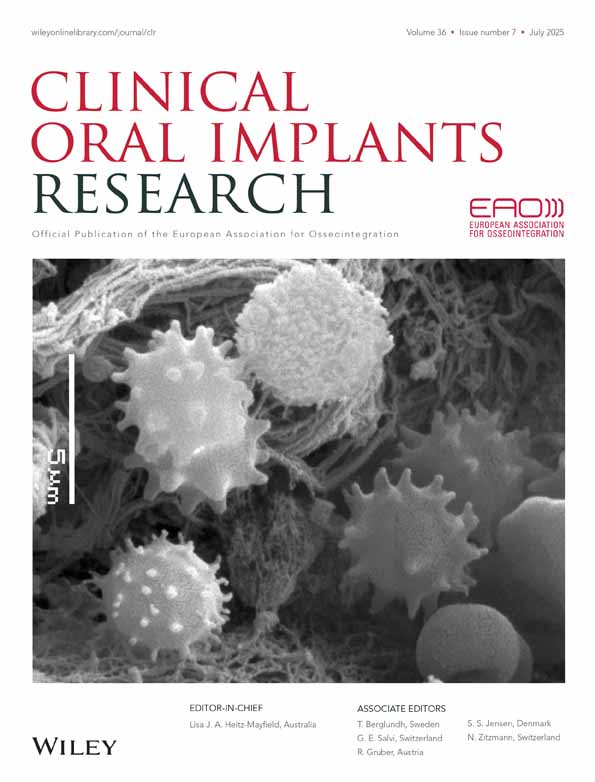Oral rehabilitation after mandibular reconstruction using an osteocutaneous fibula free flap with endosseous implants
Orale Wiederherstellung nach mandibulärer Rekonstruktion mittels osteokutaner freier Fibula Lappen mit enossalen Implantaten: Faktoren, welche das funktionelle Resultat bei Patienten mit oralen Karzinomen beeinflussen
Factors affecting the functional outcome in patients with oral cancer
Abstract
enBackground: The development of endosseous implants and free vascularized bone grafting has permitted increased possibilities of oromandibular reconstruction in patients with oral cancer. In this study, a concept combining surgical and prosthodontic treatments for mandibular fibula free flap reconstruction after tumor surgery was made based on a classification of bone defects. A follow-up study was performed to evaluate the treatment concept for oral rehabilitation in order to identify possible factors which may influence the functional result.
Material and methods: A follow-up examination included 28 patients who underwent the ablative tumor surgery and mandibular reconstruction during a 4-year period. The follow-up protocol included clinical examination, radiological evaluation, and an interview using a standardized questionnaire. The timing of the study was set to allow for a minimum 2-year follow-up (mean 45 months).
Results and conclusion: At the time of examination, prosthesis-based oral rehabilitation was completed in six patients (21%), and the prosthodontic work was still unfinished in four other patients. The other 18 had no dental prosthetic rehabilitation. Thirteen patients received a total of 37 oral implants, and 23 implants were functionally loaded. No implant loss was recorded. Oral functions such as speech, diet tolerance and oral competence were not directly affected by the presence of dentures. A decisive factor affecting the oral function was the extent of soft-tissue loss. According to the classification described here, the extent of the mandibular defect did not correlate with oral functions. The application of oral implants seemed to be advantageous for the oral rehabilitation of patients who had undergone intraoral resections.
Résumé
frLe dévelopement d'implants endoosseux et de greffes osseuses libres vascularisées a permis d'augmenter les possibilités des reconstructions bucco-mandibulaires chez les patients avec cancer buccal. Dans cette étude, un concept combinant les traitements chirurgicaux et prothétiques pour la reconstruction mandibulaire à lambeaux libres après chirurgie de la tumeur a été effectué en une classification des lésions osseuses. Un suivi a été mené pour évaluer le concept de traitement pour la réhabilitation buccale afin d'identifier les facteurs possibles qui pouvaient influencer les résultats. l'examen du suivi comprenait 28 patients qui avaient subi une chirurgie d'ablation de tumeur et une reconstruction mandibulaire durant une période de quatre années. Le protocole du suivi comprenait l'examen clinique, l'évaluation radiographique et une interview utilisant un questionnaire standardisé. Le temps du suivi était de minimum deux ans (moyenne de 45 mois). Au moment de l'examen, la réhabilitation prothétique était achevé chez six patients (21%) et le travail prothétique n'était toujours pas terminé chez quatre autres. Les 18 derniers patients n'avaient pas de réhabilitation prothétique. Treize patients ont reçu en tout 37 implants buccaux et 23 implants étaient en charge fonctionnelle. Aucun échec implantaire n'a été signalé. Les fonctions buccales telles que la phonation, la tolérance à la diète et la compétence buccale n'étaient pas directement affectées par la présence des prothèses. Un facteur décisif affectant la fonction buccale était l'étendue de la perte des tissus mous. Suivant la classification décrite içi, l'étendue de la lésion mandibulaire n'était pas en corrélation avec les fonctions buccales. Le placement d'implants buccaux semblait avantageuse pour la réhabilitation buccale chez des patients qui avaient subi des résections intrabuccales.
Zusammenfassung
deHintergrund: Die Entwicklung von enossalen Implantaten und freien vaskularisierten Knochentransplantaten resultiert in zunehmenden Möglichkeiten für die oromandibuläre Rekonstruktion bei Patienten mit oralen Karzinomen. In dieser Studie wurde ein Konzept entwickelt, welches auf einer Klassifizierung der Knochendefekte basiert und das die chirurgischen und prothetischen Behandlungen für die Rekonstruktion der Mandibula mit freien Fibula Lappen nach Tumorchirurgie kombiniert. Eine Studie mit Nachuntersuchungen wurde durchgeführt, um das Behandlungskonzept für die orale Wiederherstellung zu evaluieren, damit mögliche Faktoren, welche das funktionelle Resultat beeinflussen könnten, identifiziert werden können.
Material und Methoden: In die Nachuntersuchung wurden 28 Patienten einbezogen, welche innerhalb einer Zeitspanne von 4 Jahren eine ablative Tumorchirurgie durchgemacht und eine mandibuläre Rekonstruktion erhalten hatten. Das Nachuntersuchungsprotokoll sah eine klinische Untersuchung, eine radiologische Untersuchung und eine Befragung mittels eines standardisierten Fragebogens vor. Die Nachuntersuchung wurde nach einer Beobachtungszeit von mindestens 2 Jahren (Mittelwert 45 Monate) durchgeführt.
Resultate und Schlussfolgerungen: Zum Zeitpunkt der Untersuchung war die prothetische orale Wiederherstellung bei 6 Patienten (21%) fertig gestellt und bei 4 weiteren Patienten war die prothetische Arbeit noch im Gange. Die anderen 18 Patienten hatten keine dentale prothetische Wiederherstellung. Dreizehn Patienten erhielten total 37 orale Implantate und 23 Implantate wurden funktionell belastet. Es wurde kein Implantatverlust festgestellt. Die oralen Funktionen wie die Sprache, Essenaufnahme und orale Kompetenz wurden nicht direkt durch die Prothesen beeinflusst. Ein entscheidender Faktor, der die orale Funktion beeinflusste, war das Ausmass des Weichteilverlustes. Gemäss der hier beschriebenen Klassifizierung korrelierte das Ausmass des mandibulären Defekts nicht mit den oralen Funktionen. Der Einsatz von oralen Implantaten schein vorteilhaft zu sein für die orale Wiederherstellung von Patienten, bei welchen intraorale Resektionen durchgeführt worden waren.
Resumen
esAntecedentes: El desarrollo de implantes endoóseos e injertos libres vascularizados ha permitido el aumento de posibilidades de reconstrucción oromandibular en pacientes con cáncer oral. En este estudio, se realizó un concepto de tratamiento combinando tratamientos quirúrgicos y prostodónticos para reconstrucción mandibular con colgajo peroneal libre tras cirugía tumoral basándose en la clasificación de los defectos óseos. Se realizó un estudio de seguimiento para evaluar el concepto de tratamiento para rehabilitación oral en orden para identificar posibles factores de que puedan influir en el resultado funcional.
Material y métodos: El examen de seguimiento incluyó a 28 pacientes que se sometieron a la cirugía resectiva tumoral y a reconstrucción mandibular durante un periodo de 4 años. El protocolo de seguimiento incluyó exámenes clínicos, evaluación radiológica, y una entrevista usando un cuestionario estandarizado. El tiempo del estudio se situó en un mínimo de 2 años de seguimiento (media 45 meses).
Resultados y conclusiones: En el momento del examen, la rehabilitación basada en la prótesis se completó en seis pacientes (21%), y el trabajo prostodóntico estaba inacabado en cuatro pacientes más. Los otros 18 no tuvieron rehabilitación prostética dental. Trece pacientes recibieron un total de 37 implantes orales, y 23 implantes se cargaron funcionalmente. No se recogió ninguna pérdida de implantes. Las funciones orales tales como el habla, la tolerancia a la dieta y competencia oral no se afectaron directamente por la presencia de dentaduras. Un factor decisivo que afectó a la función oral fue la extensión de la pérdida de tejido. De acuerdo con la clasificación descrita aquí, la extensión del defecto mandibular no se correlacionó con las funciones orales. La aplicación de los implantes orales pareció ser ventajosa para la rehabilitación de pacientes que se sometieron a resecciones intraorales.





